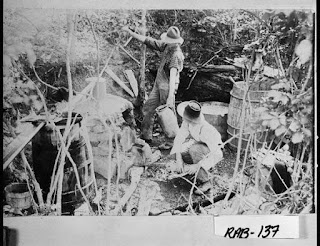On this Veteran’s Day we pause to thank and reflect on the
service and sacrifice of those that heeded the call of duty to our country,
those still living and those who have gone before us. It is estimated our country has been at war
93% of its existence1, this is just one story of one soldier.
John Price is my 3x Great Grandfather. He was born in 1789 in North Carolina2
(probably Johnston County) and died 1856 in Dunklin County, Missouri3. He married Sophia Medlock about 18514. She died in 18605. John applied for and received bounty land for
his service in the War of 1812 in Tennessee6. He enlisted November 21, 1812 and mustered
out August 22, 1813, serving under Captain Moore and Colonel Thomas Hart
Benton. His regiment was ordered to New
Orleans under the command of General Andrew Jackson.7
This was not for the famous ‘Battle of New Orleans’ that
made Andrew Jackson a national hero. It
was, however, the period that earned Jackson his nickname of “Old Hickory”.
After years of diplomatic dispute with Britain, (they hadn’t
really gotten over the whole Independence thing), war was formally declared
June 1 of 1812. Jackson was already a
colonel of the Tennessee Militia being appointed in 1801 but at the time was
enjoying the life of a wealthy plantation owner. The War Department ordered Jackson to gather 1500
militia volunteers and go to New Orleans in anticipation of a British invasion
there. This earned Tennessee its
nickname “The Volunteer State”.8
The British, however, were a no-show to New Orleans. Jackson and his troops had already traveled
over 1000 miles by flatboat and were to Natchez, Mississippi before word
reached them. General Wilkinson, a
political rival of Jackson, ordered the militia disbanded – rather than sent
home or on another military mission.
Jackson basically had over 1000 men on the frontier with no means or
supplies to return to their homes in Tennessee.9
The overland route from Natchez to Nashville, The Natchez
Trace, was not the beautiful National Parkway it is today. Originally a path utilized by Native
Americans, the Trace became a trade route for white settlers who, in the days
before steamboats, floated downriver to sell goods but had to walk back north
to their homes in Ohio and East.10
Jackson was probably familiar with this route as a business man and set out, with his men, to return to
Tennessee.
 |
| Nashville (TN) Whig April 28, 1813 |
As the War Department did not supply any means to return,
Jackson spent his own money to feed and house his men on the long march. He had no guarantee of reimbursement given
his somewhat contentious relationship with Wilkinson and the rest of
Washington. He marched alongside his
men, his officers at time surrendering their mounts to the sick and exhausted
volunteers. His men called him “tough as
old hickory” and the nickname stuck.11 They arrived at Nashville in April of 1813
averaging about 20 miles a day.12
Jackson was eventually able to secure wages for the militia, John Price
among them, for their time during the journey home13 and Jackson was
reimbursed for his expenses.
Andrew Jackson went on to become our 7th
President. John Price went on to become
a Justice of the Peace in Dunklin County, Missouri.14
Thank you, gentlemen, for your service.
Sources:
--------------------------------------------------------------------------------------------------------
1Wikipedia. Accessed November 10, 2015.
https://en.wikipedia.org/wiki/List_of_wars_involving_the_United_States.
21850 Census of Dunklin County, MO for John
Price
Year: 1850; Census Place: Independence, Dunklin, Missouri; Roll: M432_399; Page: 17A; Image: 37.
Year: 1850; Census Place: Independence, Dunklin, Missouri; Roll: M432_399; Page: 17A; Image: 37.
3 Douglas, Robert Sidney. History of Southeast Missouri.
Chicago and New York: The Lewis Publishing Company, 1912. Page 975
4 Dunklin County Mo Courthouse burned in 1872
with loss of all records. Exact marriage
date unknown.
"Historical Facts of Missouri Counties." Random Acts of Genealogical Kindness. Accessed November 10, 2015. http://www.raogk.org/missouri-genealogy/mo-counties/#courthouse.
"Historical Facts of Missouri Counties." Random Acts of Genealogical Kindness. Accessed November 10, 2015. http://www.raogk.org/missouri-genealogy/mo-counties/#courthouse.
5Douglas
6John Price (Pvt., Col. Benton’s Tenn. Militia,
War of 1812), bounty land warrant file 41615 (Act of 1855, 80 acres); Military
Bounty Land Warrants and Related Papers; Records of the Bureau of Land
Management, Can 253, Bundle 169; National Archives, Washington, D. C.
7
"Tennessee Department of State: Tennessee State Library
and Archives." Tennessee Department of State: Tennessee State Library and
Archives. Accessed November 10, 2015.
http://www.tennessee.gov/tsla/history/military/1812reg.htm.
8 "The Volunteer State Goes to War:
A Salute to Tennessee Veterans." The Volunteer State Goes to War: A Salute
to Tennessee Veterans. Accessed November 10, 2015. http://www.tn.gov/tsla/exhibits/veterans/index.htm.
9 Dyer, Oliver. General Andrew
Jackson, Hero of New Orleans and Seventh President of the United States.
New York: R. Bonner, 1891.
10 "Natchez Trace Parkway
Association." Natchez Trace Parkway Association. Accessed November 10,
2015. http://natcheztrace.org/category/history-of-the-natchez-trace/
11 Dyer
12 "Jackson's Army." Nashville
Whig, April 28, 1813.
13 "General Order."
Nashville Whig, April 28, 1813.
14 Douglas












